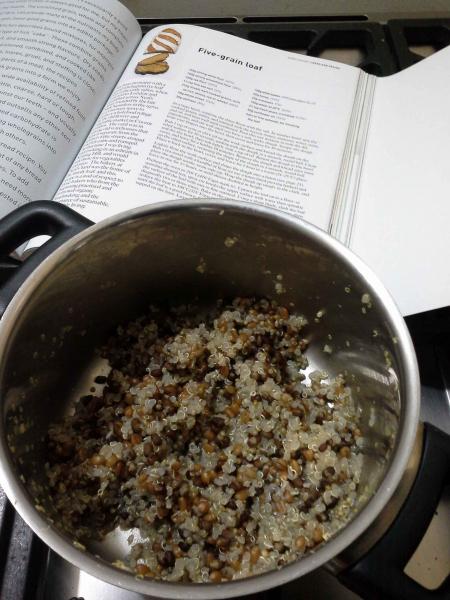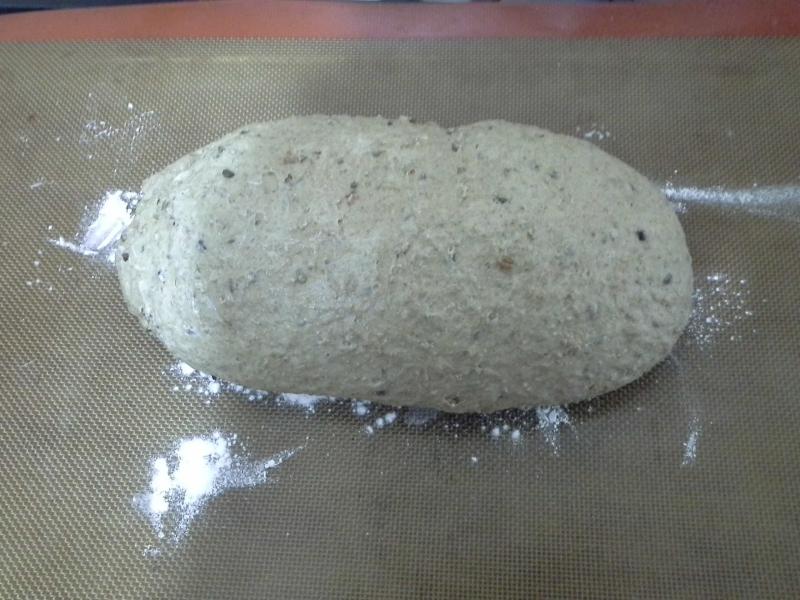
This is my take on the 5 grain loaf as described in "The handmade loaf: Contemporary recipes for the home baker" by Dan Leopard.
A book which I certainly recommend, if only for the sheer variety of the recipes and the accessibility for the average amateur baker. I usually 'roll my own' but when following recipes and preparation descriptions they invariably turned out well. Plus, they're beautifully illustrated.
I'm not sure about copyright restrictions so won't post the detailed recipe here but in general terms, preparing it involves:
1. A day before, preparing 100 gr. of white leaven (at 100% hydration)
2. Preparing a boiled whole grains soaker; many options are available but what I did was boiling a mixture of quinoa, whole millet, wheat berries, lentils (I used black 'urad dal' for their earthly flavour but any whole lentil will work). Be sure to pre-soak the quinoa and to rinse well before boiling as else you'll get some very unpleasantly tasting saponins in your loaf.

3. Preparing the flour mix, consisting out of about equal parts strong white bread flour, strong brown wholewheat flour and rye flour. I added one extra part of millet flour, salt and 3 grams of bread machine yeast.
Method:
Let cool the cooked grain soaker and set apart 200 gr. To that are added 50 grams of sunflower oil, 25 grams molasses, the leaven, water required for baking and 50 grams of honey. I selected French chestnut blossom honey for its pronounced taste. Mix it all well, you'll end up with a not very appetising looking brew.
Add this to the dry flours and mix until incorporation, I gave it a 25 minute rest afterward.
In the book an elaborate manual kneading/folding technique is described. I just mixed mechanically for 5 minutes at low speed, followed by 5 minutes at high speed in order to maximally develop gluten structure. This is very important as 50% of my flours do not have any gluten to speak of (rye and millet).
You will end up with a very sticky dough. I gave it a 1 hour bulk rise at 25 centigrade, by that time it had doubled thanks to the leaven, added yeast and the sugars present, folded, let rest for 15 minutes, then folded again and shaped.

Finally,I proofed it for another 1.5 hours at 25 centigrade until it had doubled. Due to the quite high hydration, low gluten presence and oil it will have a tendency to spread somewhat so tight initial shaping is very important or you could proof it in a banneton or bread tin. I just went with a free shape and let it proof, covered in oiled cling film on the baking tray.
After proofing, spray with water, dust with rye flour or with rolled oats and score. This is a loaf that benefits from a long bake; give it an initial 30 minutes in a 215 centigrade oven with steam, then reduce temperature to 190 centigrade and bake for another 20-25 minutes until it's well browned and sounds hollow when tapped.
Impressions after cooling, slicing and tasting:
Very nice, soft yet chewy crumb, contrary to what you might deduce from the picture is was quite open but not as pronounced, due to lower gluten presence in the mix.
It tastes very nice and the grains present an interesting contrast, I especially appreciate the lentils for the earthy note they bring. Not so sure about quinoa, it becomes almost completely resorbed and taste-wise it is quite neutral. The chestnut honey provided a pronounced aroma, if you like a more neutral taste or bring the grains more forward then I feel it would be better to select a more neutral tasting honey. The bread pairs very nicely with both young cheese and cheeses that have a really pronounced taste.
All things considered this was fun to prepare and a lot less work than one might imagine! Enjoy!
- Xenophon's Blog
- Log in or register to post comments
It sounds very interesting, especially using lentils, I would never have thought of that.
I like to tinker with all kinds of locally available ingredients (and if you live in India you'd better learn to appreciate lentils ;-).
If you want to try lentils, make sure they're whole and unhulled and pre-cook them, you want them cooked to about 90%, no more or they'll turn to mush. If you have an Indian store where you are and want to try this slightly earthly tasting variety, ask them (if they know Hindi) for 'Urad dal, saboot' (saboot means whole, unhulled).
I have Urad Dal in my cupboard, I am rather fond of lentils and make daal quite frequently, though usually with red lentils, but bread is a new one on me.